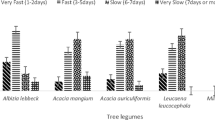Abstract
Fortytwo isolates of root nodule bacteria obtained from 19 tree legumes were studied for their morphological, physiological and biochemical characteristics. All the isolates grew well at 0.8–1.8 per cent sodium chloride concentration. Optimum temperature range for the isolates was found to be 35°–40°C.
Strains of Rhizobium, specific toVigna radiata var.aureus (Syn.Phaseolus aureus) green gram andVigna radiata var.mungo (Syn.Phaseolus mungo) black gram, were found to be selective in nodulating the tree legumes. Isolates from tree legumes maintained their infectivity after plant passage through green gram and black gram. All the six rhizobial isolates from tree legumes, when tried on green gram and black gram, were found to be superior to the uninoculated control and in some cases performed better than the specific rhizobia.
Similar content being viewed by others
References
Allen, O. N. and Allen, E. K. 1936 Root nodule bacteria of some tropical leguminous plants I. Cross inoculation studies withVigna sinensis. Soil Sci.42, 61.
Allen, O. N. and Allen, E. K. 1939 Root nodule bacteria of some tropical leguminous plants II. Cross inoculation test with cowpea group. Soil Sci.47, 63.
Basak, M. K. and Goyal, S. K. 1975 Studies on tree legumes. I. Nodulation pattern and characterization of the symbiont. Ann. Arid Zone14, 367.
Basak, M. K. and Goyal, S. K. 1980 Studies on tree legumes II. Further additions to the list of nodulating tree legumes. Plant and Soil55, 33.
Bisset, K. A. 1959 Some characters of Rhizobium strains from tropical legumes. J. Gen. Microbiol.20, 89.
Bowen, G. D. 1956 Nodulation of legumes indigenous to Queensland. Queensland J. Agric. Sci.13, 47.
Carroll, W. R. 1934 A study ofRhizobium species in relation to nodule formation on the roots of Florida legumes I. Soil Sci.37, 117.
Conklin, M. E. 1936 Studies on root nodule organisms of certain wild legumes. Soil Sci.41, 167.
Fred, E. B., Baldwin, I. L. and McCoy, E. 1932 Root nodule bacteria and leguminous plants. Univ. Wis. Press, Madison, 118 p.
Gibson, A. H. 1961 Root temperature and nitrogen fixation. Nature London191, 1081.
Graham, P. H. and Parker, C. A. 1964 Diagnostic features in the root nodule bacteria of legumes. Plant and Soil20, 383.
Habish, H. A. and Khairi, A. M. 1968 Nodulation of legumes in the Sudan: Cross inoculation groups and the associatedRhizobium strains. Exp. Agric.4, 227.
Habish, H. A. and Khairi, A. M. 1970 Nodulation of legumes in Sudan II:Rhizobium strains and cross inoculation ofAcacia spp. Exp. Agric.6, 171.
Hofer, A. M. 1935 Methods of distinguishing between legume bacteria and their common contaminant. J. Am. Soc. Agron.27, 228.
Hofer, A. W. 1941 A characterisation ofBacterium radiobacter (Beijerinck and Van Delden) Lohnis. J. Bacteriol.41, 193.
Koser, S. A. 1923 Utilization of the salts of organic acids by the colonaerogenes groups. J. Bacteriol.8, 493.
Lange, R. T. 1961 Nodule bacteria associated with the indigenous leguminosae of South Western Australia. J. Gen. Microbiol.26, 351.
Lange, R. T. 1962 Susceptibility of indigenous South West Australian legumes to infection byRhizobium. Plant and Soil17, 134.
McKnight, T. 1949 Efficiency of isolates ofRhizobium in the cowpea group, with proposed additions to the group. Q. J. Agric. Sci.6, 61.
Meyer, D. R. and Anderson, A. J. 1959 Temperature and symbiotic nitrogen fixation. Nature, London183, 61.
Norris, D. O. 1965 Acid production byRhizobium. A unifying concept. Plant and Soil22, 143.
Pillai, R. N. and Sen, A. 1973 Salt tolerance ofRhizobium fromDolichos labalb. Zentralbl. Bakteriol. Parasitenkd. Infektion Kr. Hyg. II.128, 538.
Smith, N. R., Cordon, R. E. and Clark, F. E. 1952 Aerobic spore forming bacteria. U. S. Dep. Agric. Monograph No.16, Washington.
Subba Rao, N. S., Lakshmi Kumari, M., Singh, C. S. and Magu, S. P. 1972 Nodulation of lucerne (Medicago sativa L.) under the influence of sodium chloride. Indian J. Agric. Sci.42, 384.
Subba Rao, N. S., Lakshmi Kumari, M., Singh, C. S. and Biswas, A. 1975 Salinity and alkalinity in relation to legume-Rhizobium symbiosis. Proc. Indian Nat. Sci. Acad. PartB, 40, 544.
Yadav, N. K. and Vyas, S. R. 1971 Effect of salts and pH on the growth of Rhizobium strains. Indian J. Microbiol.11, 97.
Yadav, N. K. and Vyas, S. R. 1971 Note on the response of root nodule rhizobia to saline, alkaline and acid conditions. Indian J. Agric. Sci.41, 1123.
Zobbell, C. E. and Felthem, C. B. 1934 A comparison of lead and iron as detectors of H2S production by bacteria. J. Bacteriol.28, 169.
Author information
Authors and Affiliations
Rights and permissions
About this article
Cite this article
Basak, M.K., Goyal, S.K. Studies on tree legumes. Plant Soil 56, 39–51 (1980). https://doi.org/10.1007/BF02197951
Received:
Revised:
Issue Date:
DOI: https://doi.org/10.1007/BF02197951




